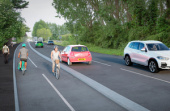Updated Walking and Cycling Strategy, 2016 to 2026

Document type:
Publisher:
The purpose of this document is:
- To clearly state West Sussex County Council’s aims and objectives for cycling and walking between 2016 and 2026
- To determine the Council’s priorities for funding reflecting the overall walking and cycling aspirations of the Council
- To provide guidance in support of prioritising cycling and walking infrastructure in new development
- To provide a framework through which local interest and community groups can make suggestions for the development of cycling and walking improvements
- To support interested parties in securing additional funding where available
This strategy outlines the design and safety principles for walking and cycling that the County Council will follow, and developers will be expected to follow, when implementing infrastructure schemes. The strategy also provides a mechanism by which schemes can be identified and prioritised, thereby enabling the County Council to direct future investment (such as contributions from future development) and support future funding bids (such as the Department for Transport’s Access Fund).
Additionally, the Government has recently consulted on its draft Cycling and Walking Investment Strategy (CWIS) and publication of the final document is expected in the summer of 2016. It is our intention that this strategy will support delivery of the CWIS and the Government’s aims to:
- Double levels of cycling by 2025
- Reduce each year the rate of cyclists killed or injured on English roads
- Reverse the decline in walking activity, and
- Increase the percentage of children aged 5-10 who usually walk to school.
By promoting walking and cycling this strategy will support the County Council’s wider objectives and our three core priorities:
- Giving children the best start in life
- Championing the West Sussex Economy
- Promoting Independence in Later Life
The West Sussex Walking and Cycling Strategy also supports the West Sussex Transport Plan 2011 – 2026 objectives. This includes four strategies based on the following priorities that guide the County Council’s approach to maintaining, managing and investing in transport, and meeting the main objective of improving quality of life for the people of West Sussex:
- Promoting economic growth
- Tackling climate change
- Providing access to services, employment and housing
- Improving safety, security and health
Recent studies into the benefits of walking and cycling in pursuit of the above objectives are compelling. Reporting on the benefits of sustainable travel initiatives such as; the Sustainable Travel Towns, Cycling Demonstration Towns; Local Sustainable Transport Fund; Cycling Ambition Grants and the Linking Communities Fund; the Government reports benefit cost ratios between 2:1 and 32:1, typically in the region of 5:1 and 6:1.
The financial benefits accruing from health improvements from a more physically active population choosing cycling and walking are also convincing. The direct cost of illness as an outcome of inactivity to the NHS are around £1 billion per year while indirect costs are estimated as £8.3 billion per year. 2 Investing in walking and cycling as a key means by which physical activity can be built into people’s lives achieves an average benefit cost ration of around 6:1.
Objectives
The objectives of this walking and cycling strategy are:
- To ensure that cycling and walking are recognised as important travel modes and therefore part of the transport mix
- To make cycling and walking the natural choice for shorter journeys (such as journeys to school), or as part of a longer journey
- To reduce the number of cyclists and pedestrians that are killed or seriously injured on our roads
- To support economic development by facilitating travel to work and services without a car
- To reduce congestion and pollution by encouraging and enabling people to travel without a car
- To increase levels of physical activity to help to improve physical health
- To help to maintain good mental health and staying independent later in life
- To increase the vitality of communities by improving access by bicycle and on foot
- To help people to access rural areas and enjoy walking and cycling
Note: numbering does not reflect priority. Objectives are of equal importance.
- Log in to post comments




